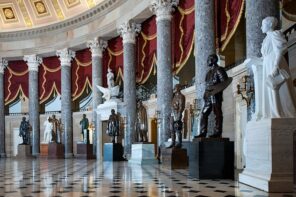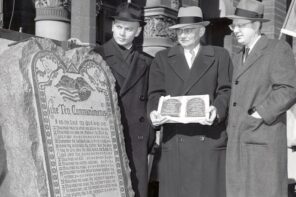Trump’s second attempt at banning travel from certain Muslim-majority countries is clearly written to avoid being struck down under the Establishment Clause. Most notably, it no longer contains provisions that preference entry for religious minorities—language the President himself admitted was intended to prioritize entry for Christian rather than Muslim refugees.
So why isn’t the new EO constitutional, at least with regard to First Amendment claims? Because cutting its most obviously discriminatory provision doesn’t fix the fact that the new EO was passed with the same invalid purpose as the President’s first attempt—to reduce Muslim immigration into the U.S. When a candidate campaigns for nearly two years on the promise of banning, profiling, and even registering Muslims, that is context that a court can—and should—consider in evaluating whether his actions are motivated by religious animus or legitimate security concerns.
In 2005, the Supreme Court issued two decisions on the question of whether displaying the Ten Commandments in or near a courthouse violated the Establishment Clause of the First Amendment. The cases came out split, with one display upheld and the other held unconstitutional. The takeaway? Context and history matter.
These decisions serve as helpful background for why a quick fix to Trump’s Executive Order on Immigration doesn’t resolve all the EO’s constitutional problems.
In one of the cases, McCreary County v. ACLU, the displays at issue were the third in a series of exhibits that had been repeatedly challenged as unconstitutional. The first displays—installed in two Kentucky county courthouses—were large, gold-framed copies of the Ten Commandments, with a citation to the Book of Exodus. In response to a suit by the ACLU, the counties expanded the displays to include additional documents in smaller frames, each with a religious theme, including the “endowed by their Creator” passage from the Declaration of Independence and the national motto, “In God We Trust.”
When a District Court preliminarily enjoined both the original and the expanded displays, the counties installed a third version, this time consisting of nine framed documents including the Ten Commandments, Magna Carta, Declaration of Independence, and Bill of Rights. In explaining its decision to strike down even this seemingly acceptable display, the Supreme Court noted: “the purpose apparent from government action can have an impact more significant than the result expressly decreed” (emphasis added).
In other words, the counties weren’t fooling anyone.
In order to be upheld under the Establishment Clause, a government action must have a valid secular purpose. While courts typically give deference to the secular intent proffered by legislatures, the purpose has to be “genuine, not a sham.” In this case, it was obvious to the Court that the counties’ intent in creating the third round of displays was no different than their intent for the original display: they “were simply reaching for any way to keep a religious document on the walls of courthouses constitutionally required to embody religious neutrality.”
In contrast, the Court in Van Orden v. Perry held that it was permissible for Texas to accept and display a Ten Commandments statue donated by a civic organization on the state capitol grounds, alongside 17 other monuments and 22 historical markers. In this case, there was no history indicating a legislative intent to endorse or advance religion.
The history of Trump’s two Executive Orders recalls the counties’ efforts in McCreary to water down a religious display simply to meet legal approval, without changing its underlying intent. In the years leading up to the EO, President Trump repeatedly pledged to ban Muslims from entering the country. (He also made comments supporting Muslim profiling, the creation of a Muslim registry, and the closure of mosques.) Trump sometimes varied his language, calling his plan “extreme vetting” or emphasizing its application to “terror nations” rather than Muslim-majority nations.
After the issuance of the first order, however, Trump advisor Rudy Giuliani openly admitted that the President intended to craft a Muslim ban that would withstand judicial scrutiny. When the ban was enjoined, Trump stated in a press conference that the administration could “tailor the [new] order to that decision and get just about everything, in some ways more.” White House advisor, Stephen Miller, also stated that the new EO contained “mostly minor, technical differences,” and would “have the same, basic policy outcome for the country.”
Thus, despite the elimination of the explicit religious preference, there’s no indication that the new order should be treated any differently from the last one when it comes to determining whether the administration had a valid, secular, non-discriminatory purpose in issuing the EO.
This is certainly not to say that Trump can never pass a law on immigration or national security that won’t violate the Establishment Clause. The McCreary Court explained that it did not hold that the counties’ “past actions forever taint any effort on their part to deal with the subject matter.” However it does mean that Trump cannot avoid the ample and longstanding evidence that his EO is intended to be a Muslim ban simply by removing the language that most clearly identifies it as one.





